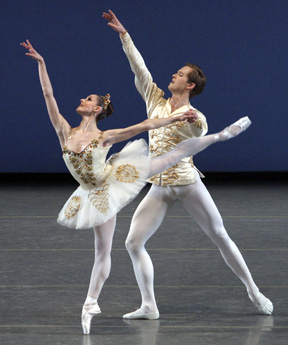Winter Repertory Season Opens
“Divertimento
No. 15”, “The Four Temperaments”, “Cortège
Hongrois”
New York City Ballet
New York State Theater
New York, New York
January 4, 2005
by
Mary Cargill
copyright
© 2004 by Mary Cargill
 New
York City Ballet’s first performance after the long run of “Nutcrackers”
was a Balanchine extravaganza, a welcome bouquet to the audience and a
challenge to the dancers. “Divertimento No. 15”, conducted
at quite a clip by quest conductor George Cleve, despite a few mishaps
(Ashley Bouder, it turns out, is human and can fall), looked much more
polished and regal than it did in its last outing.
New
York City Ballet’s first performance after the long run of “Nutcrackers”
was a Balanchine extravaganza, a welcome bouquet to the audience and a
challenge to the dancers. “Divertimento No. 15”, conducted
at quite a clip by quest conductor George Cleve, despite a few mishaps
(Ashley Bouder, it turns out, is human and can fall), looked much more
polished and regal than it did in its last outing.
Miranda Weese, as the leader of the exalted band, does not have the incisive turns she threw off before her injury, but danced with a warmth and generosity, and a glorious upper body, that more than compensated. The other variations, despite the sometimes frantic speed (a modern day Emperor might say “Too many notes, Mr. Mozart and too many steps, Mr. Balanchine”) were all individually characterized. Rachel Rutherford, in the third variation, had a noble and expansive graciousness. Janie Taylor, in the second variation, looked much stronger than she has in the past, and danced with an ethereal freedom. Bouder, despite landing on the floor in the middle of some very fast footwork, danced with her usual detailed power, and showed a welcome creaminess in the adagio. Megan Fairchild made her debut in the first variation; perhaps due to the speed, her arms looked a bit brittle, but her footwork was elegant. She has the air, rare in a dancer so young, of seeming to be aware of the audience, while dancing unselfconsciously; she never just does steps.
The ballet is one of Balanchine’s most sublime (and most difficult) of his classical expositions, the ultimate vision of Petipa’s glorious variations. I do wish, however, that the fussy, Austrian shade costumes could be simplified—they make the dancers look a bit like little 18th century Scarlett O’Haras who have just raided their mothers’ curtains.
 “The
Four Temperaments”, too, was famously costume-challenged, but the
revised black and white look is astringent and timeless. Peter Boal gave
one of his last performances (before leaving to head Pacific Northwest
Ballet) of Melancholic, and perhaps the knowledge that this was the last
time I would see it made it especially moving. The purity of his opening
arabesque makes the sudden drop to the ground and the more naturalistic
push of his arms almost shockingly painful. Yet this is not a self-indulgent,
individualist performance; it is pain and loneliness on an abstract and
universal level. It will be a long time, I expect, before we see such
a combination of beauty and maturity.
“The
Four Temperaments”, too, was famously costume-challenged, but the
revised black and white look is astringent and timeless. Peter Boal gave
one of his last performances (before leaving to head Pacific Northwest
Ballet) of Melancholic, and perhaps the knowledge that this was the last
time I would see it made it especially moving. The purity of his opening
arabesque makes the sudden drop to the ground and the more naturalistic
push of his arms almost shockingly painful. Yet this is not a self-indulgent,
individualist performance; it is pain and loneliness on an abstract and
universal level. It will be a long time, I expect, before we see such
a combination of beauty and maturity.
It as not present, unfortunately, in Alexandra Ansanelli’s debut as Sanguinic, which was danced rather as if she had hoped to do Choleric, strong but not serene. It was a very twitchy performance, and she used her eyes as if she were searching for the spotlight. There was almost no interaction with her partner, Stephen Hanna, which was a shame, because he was worth watching for his purity and restrained elegance; his beats were especially sharp. In the Spring 1987 issue of “Ballet Review” Merrill Brockway, who filmed “The Four Temperaments” for television, said Balanchine was especially concerned about the high kicks in that ballet. He “was not buying high kicks”, according to Brockway. It is a good thing Balanchine didn’t see Faye Arthurs’ first movement, since she spent the evening whacking her head.
There was no extraneous whacking in Sofiane Sylve’s New York debut in “Cortège Hongrois”, though she does have glorious extensions. “Cortège Hongrois” is not a great Balanchine ballet; it is basically a set of finales set to excerpts from Glazounov’s “Raymonda”. It does include one great section, a minor revision of Petipa’s solo for Raymonda, which is one of his most magnificent creations, an apotheosis of womanhood, choreographed originally for a mature Pierina Legnani, and set by Balanchine as a farewell present to Melissa Hayden. Even wearing the Miss Hungarian Pastry of 1956 tiara, Sylve was absolutely commanding, riding the wave of elegant nostalgia in the music, saluting us from the misty Middle Ages of the story.
Her remote radiance was complimented by Jenifer Ringer’s full-blooded gypsy—Ringer, with her partner James Fayette, understood that even faux folk-dancing is about courtship, and unlike the other folk couples, were eager actually to look at each other. Much better ballets have certainly been a lot less fun to watch.
Photos:
First: Sofiane Sylve and Charles Askegard in “Cortège Hongrois”.
Photo: Paul Kolnik.
Second: Alexandra Ansanelli and Stephen Hanna in "The Four Temperaments."
Phot: Paul Kolnik.
Volume
3, No. 1
January 4, 2005
www.danceviewtimes.com
Copyright
©2005 by Mary Cargill
|
|
|